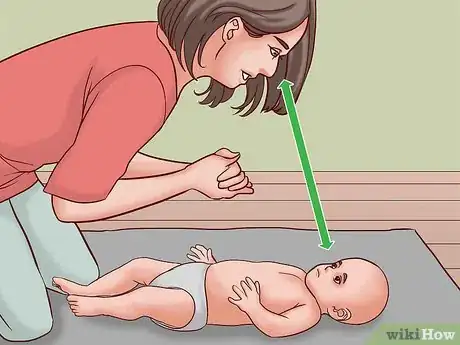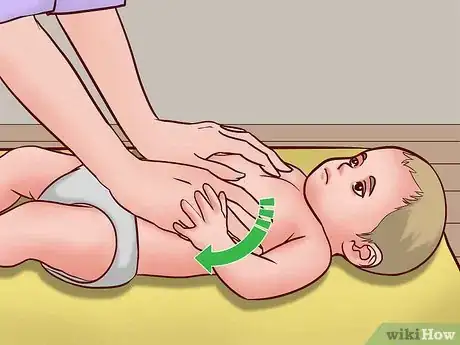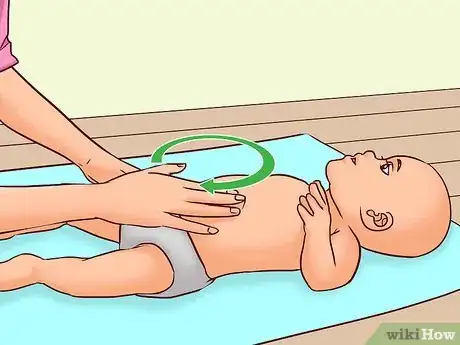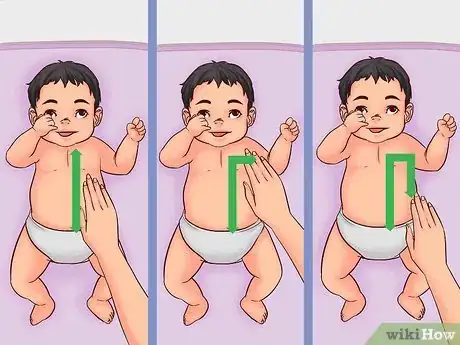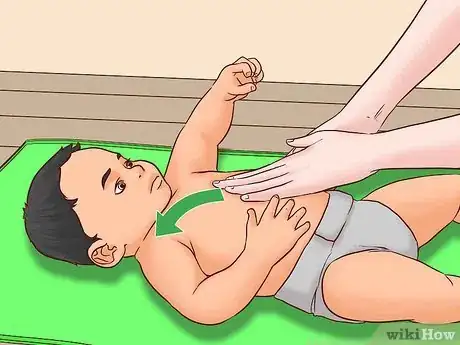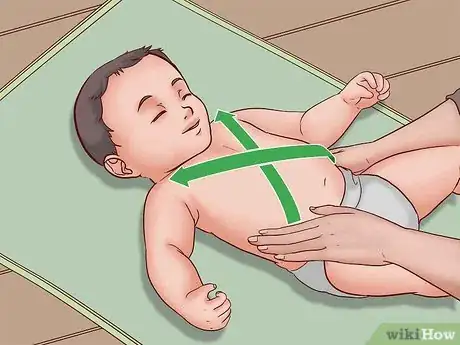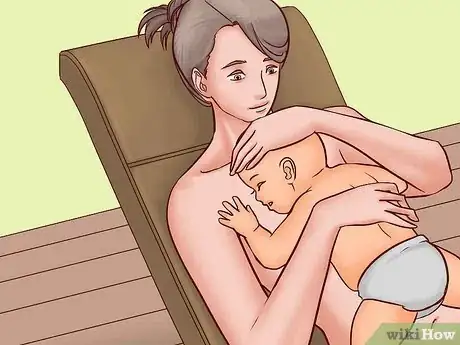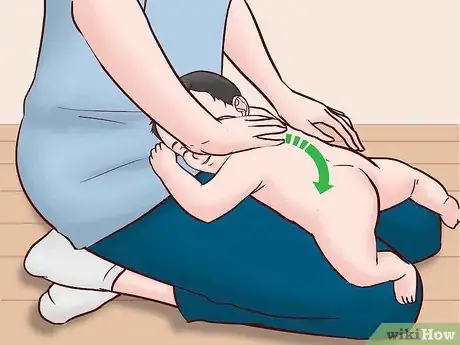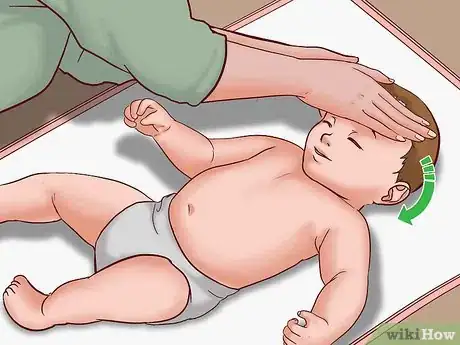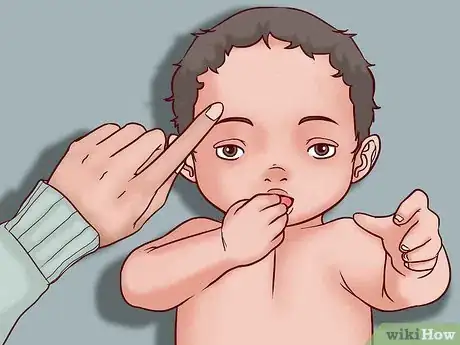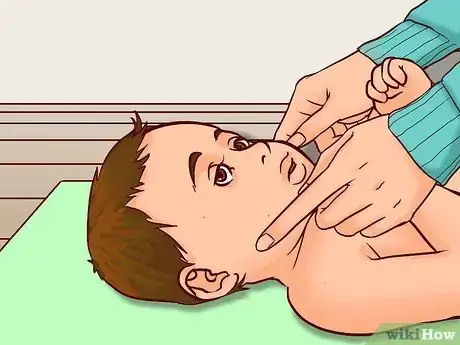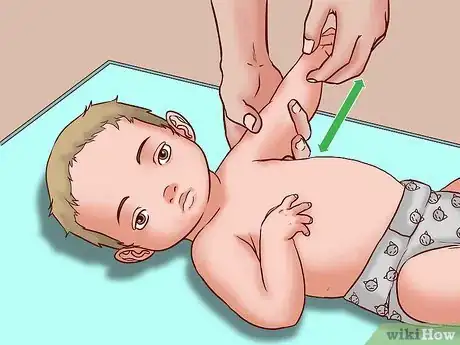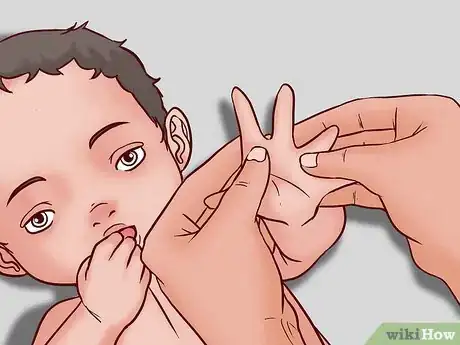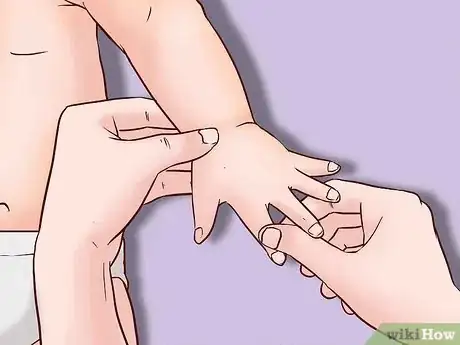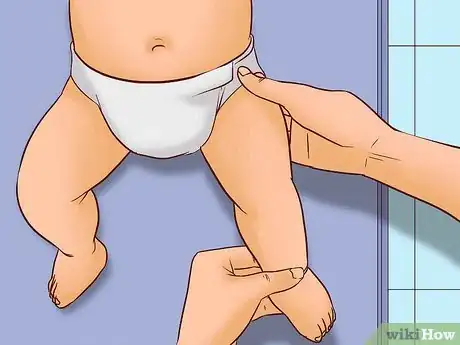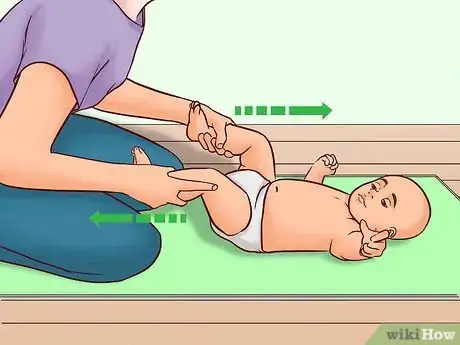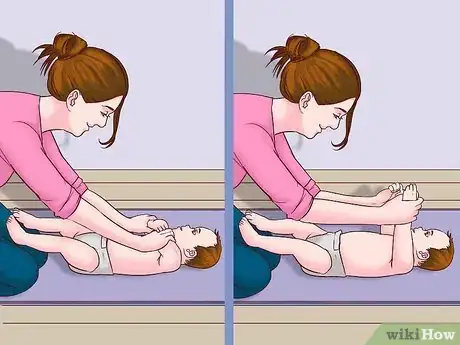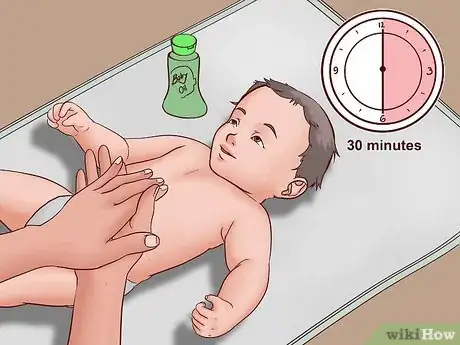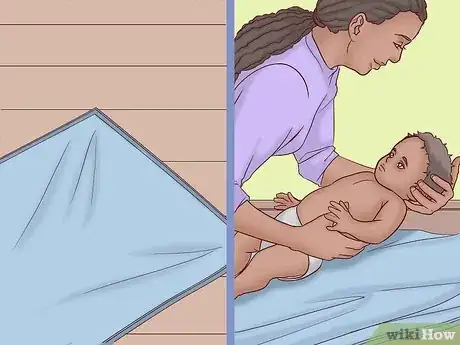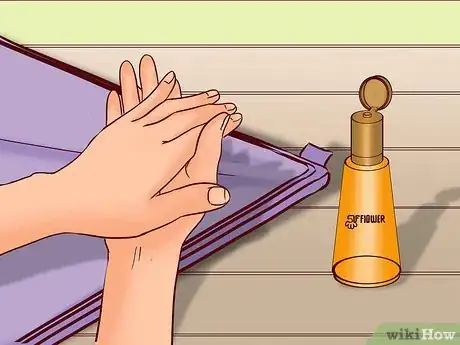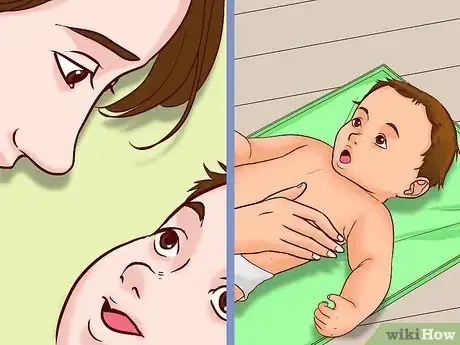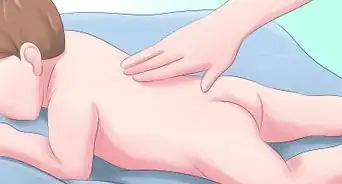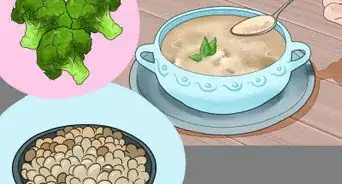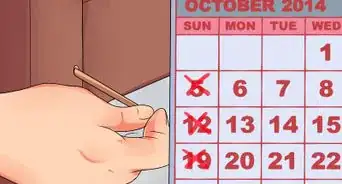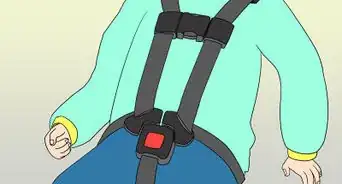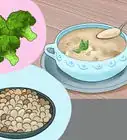This article was co-authored by Deanna Dawson-Jesus, CD (DONA). Deanna Dawson-Jesus is a Birth Doula, Childbirth, and Lactation Educator based in Danville, California. As the owner of Birthing Babies - A Celebration of Life, Deanna has 19 years of birth doula experience and has assisted with over 250 births. She also has over five years of postpartum doula experience and assists more than ten families. Deanna has additional extensive training in Assisted Reproductive Technologies, VBAC support, and Perinatal Loss Support. She is a Certified Birth Doula by DONA International and teaches at Blossom Birth and Family.
There are 9 references cited in this article, which can be found at the bottom of the page.
This article has been viewed 154,553 times.
After your baby is born, it’s time to start that exciting process of bonding with them in the outside world! Massaging your newborn is a wonderful way to build a close relationship with your baby.[1] It’s also been shown to improve babies’ immune systems, weight gain, and motor skills.[2] You can start massaging your baby right after birth, although it’s a good idea to double-check with your doctor before doing so.[3] Massage each part of the baby’s body to soothe them -- and you! Create a calming environment with warmed-up natural oils, songs, and a soft blanket.
Steps
Massaging Your Baby’s Tummy, Chest, and Back
-
1Maintain eye contact and speak softly to your baby. Establish eye contact with your baby and use a soft tone of voice to speak to them during the massage. This will help strengthen the bond between the two of you and help your baby learn to regulate emotion.[4]
-
2Move your hand from the base of the rib cage down the belly. Place your hand palm-side down on the baby’s torso. Stroke downward, applying just a little bit of pressure. Move across horizontally to reach the left and right sides of your baby’s body.[5]
- Be very gentle with the pressure, especially in your baby’s first few weeks of life. While a little pressure has been shown to enhance the benefits of massage, you don’t want to push too hard on your baby’s little body.[6]
Advertisement -
3Use your fingertips to make a circle around their abdomen. Move in a clockwise direction. This particular massage helps with digestion. Don’t be surprised if your little one passes some gas! If they do, it’s a good sign the massage is working.[7]
-
4Do the “I love you” stroke for a sweet and soothing motion. This movement combines the letters “I,” “L,” and “U.” Start by tracing the letter “I” (just do an up-and-down line) on the baby’s left side. Then, make a backwards “L” by stroking across your baby’s chest below the rib cage and down their left side. Finally, trace an upside-down “U” by moving your fingers up their right side, around their navel, and down their left side.
- As you do this, say “I love you” to your baby, matching the word to the motion.
-
5Trace a heart across your baby’s chest. Use your fingertips for a gentle amount of pressure. Start at their sternum (in the middle of the bottom of their rib cage) and move upwards across their chest to the shoulders. Make your fingertips meet in the middle of their upper chest.[8]
-
6Make an “X” over your baby’s whole torso. Stroke across from the baby’s hip up to their shoulder. Then repeat on the other side.[9]
-
7Transfer your baby to your lap or bare chest for the back massage. If you’d prefer, you can also lay them down on their tummy on a blanket in front of you. Either way, ensure that their head is turned to 1 side so they can breathe.[10]
-
8Make circles and stroke up and down your baby’s back. Use your fingertips and avoid pressing on your baby’s spine. Instead, trace small circles on the left and right sides of your baby’s back. Then, stroke your fingers from your baby’s neck down to their buttocks and back up again. Finally, use the tips of your fingers to form a rake and very gently “rake” up and down your little one’s back.[11]
Massaging Your Baby’s Head and Face
-
1Cradle your baby’s head in both hands to stroke their scalp. Reach underneath your baby’s head and neck to make sure they’re well supported. Use your fingertips to trace very small circles on their scalp. Avoid the soft spot right at the top of their head.[12]
-
2Make a heart around the edges of your baby’s face. Use the tips of your pointer fingers. Start at the crown of your baby’s head and move down to their chin.[13]
-
3Stroke your baby’s eyebrows, nose, and cheeks. You can use your pointer fingers for this movement, as well. Be very gentle and move slowly. Consider telling your baby which part of their face you’re touching![14]
-
4Massage your baby’s jaw in soft, gentle circles. Only use your fingertips and apply just a small amount of pressure. You can then trace a circle around their little cheeks.[15]
Massaging Your Baby’s Arms and Legs
-
1Make a bracelet with your fingers and stroke their arms. Hold your baby’s wrist gently with 1 hand. With the other hand, encircle your baby’s arm below their shoulder and stroke gently downward.[16] You can also gently “milk” the arm by applying just a little pressure as you move downward. Repeat the movements on the other side.
- You can reverse and repeat this movement several times on both sides.
-
2Rub your baby’s palms with your thumbs. Tap your baby’s upper arm with your fingertips to relax it. Then, move your thumbs from the heel of their hand up to the top of their palm. Repeat on their other hand.[17]
-
3Squeeze and straighten each tiny finger. Turn your baby’s hand over and stroke from their wrist to the tip of each finger. When you switch your attention to each little finger, be very gentle with your pressure. Be sure to do both hands![18]
-
4Form a “C” around your baby’s thigh. This is the same bracelet movement you performed on your baby’s arms. Stroke both the inside and outside of your baby’s leg, moving from their hip down to their ankle. Reverse and repeat the movement a few times, then move to the other side.[19]
-
5Use your thumbs and fingertips to massage your baby’s feet. Move your thumbs up and over each other like you’re climbing a ladder across the bottom of your baby’s foot. Then, stroke from their heel up to their toes in one motion. You can also gently trace circles on the tops of their feet. Finally, make very small circles with your fingertips around their ankles.[20]
-
6Flex your baby’s legs in a gentle bicycle motion. This “flexion” part of the massage should help your baby gain weight, improve their bone development, aid with digestion, and soothe gas pains.[21] Grasp your baby’s feet gently in both hands. Then, pump your baby’s legs so they move in and out against their tummy.
-
7Flex your baby’s arms in and out like butterfly wings. Hold your baby’s hands and smile at them. Then, move your baby’s arms in and out across their chest, helping them bend their elbows.
Creating the Perfect Massage Experience
-
1Set aside at least 30 minutes for your massage session. Choose a time when you know you won’t be rushed. This will make it a calm and relaxed experience for both you and your baby.
- Since the massage may relax your baby and make them sleepy, consider making it part of your bedtime routine. This can also help them learn to associate massage with going to sleep.[22] If you massage your baby before their bath, for example, you’ll be able to rinse off any oils you use during the session.
-
2
-
3Warm up the room to about 75 °F (24 °C) and set out a blanket. Since you’ll be undressing your baby down to their diaper, it’s best if the room is on the warmer side. This will keep your baby from getting chilled during the session. Lay out a thick and soft blanket to lay the baby on during the massage.[25]
-
4Use edible, unscented oils to enhance the benefits of massage. Natural oils like coconut and safflower are best, as these won’t clog the baby’s pores.[26] While you don’t have to use oil, it’s been shown to have some benefits. It should keep your baby’s skin nice and moist, and it might also lead to some extra weight gain.[27]
- Warm up the oils by rubbing a small amount in between your fingers.
-
5Sing to your baby or play soothing lullabies. Use the sound of your voice to help your baby relax. Speak to them in a sing-song tone while you play some instrumental music in the background. Or sing the songs yourself to provide the music on your own![28]
-
6Learn your baby’s positive and negative responses. Over time, you’ll learn your baby’s individual signs. In general, expect a happy baby to be cooing, passing gas, making eye contact with you, and breathing easily and evenly. A stressed-out baby might get the hiccups, have patches of red or pale skin, avoid focusing on you, and/or cry.[29]
Expert Q&A
-
QuestionHow do you stimulate a newborn baby?
 Deanna Dawson-Jesus, CD (DONA)Deanna Dawson-Jesus is a Birth Doula, Childbirth, and Lactation Educator based in Danville, California. As the owner of Birthing Babies - A Celebration of Life, Deanna has 19 years of birth doula experience and has assisted with over 250 births. She also has over five years of postpartum doula experience and assists more than ten families. Deanna has additional extensive training in Assisted Reproductive Technologies, VBAC support, and Perinatal Loss Support. She is a Certified Birth Doula by DONA International and teaches at Blossom Birth and Family.
Deanna Dawson-Jesus, CD (DONA)Deanna Dawson-Jesus is a Birth Doula, Childbirth, and Lactation Educator based in Danville, California. As the owner of Birthing Babies - A Celebration of Life, Deanna has 19 years of birth doula experience and has assisted with over 250 births. She also has over five years of postpartum doula experience and assists more than ten families. Deanna has additional extensive training in Assisted Reproductive Technologies, VBAC support, and Perinatal Loss Support. She is a Certified Birth Doula by DONA International and teaches at Blossom Birth and Family.
Birth & Postpartum Doula, Childbirth, & Lactation Educator Birth & Postpartum Doula, Childbirth, & Lactation EducatorExpert AnswerCreating skin-to-skin contact has many benefits, including creating a calming and comforting effect. Placing your baby on your bare chest allows them to hear your heartbeat, feel the warmth of your skin, and smell your skin.
Birth & Postpartum Doula, Childbirth, & Lactation EducatorExpert AnswerCreating skin-to-skin contact has many benefits, including creating a calming and comforting effect. Placing your baby on your bare chest allows them to hear your heartbeat, feel the warmth of your skin, and smell your skin. -
QuestionDoes massage help my baby?
 Deanna Dawson-Jesus, CD (DONA)Deanna Dawson-Jesus is a Birth Doula, Childbirth, and Lactation Educator based in Danville, California. As the owner of Birthing Babies - A Celebration of Life, Deanna has 19 years of birth doula experience and has assisted with over 250 births. She also has over five years of postpartum doula experience and assists more than ten families. Deanna has additional extensive training in Assisted Reproductive Technologies, VBAC support, and Perinatal Loss Support. She is a Certified Birth Doula by DONA International and teaches at Blossom Birth and Family.
Deanna Dawson-Jesus, CD (DONA)Deanna Dawson-Jesus is a Birth Doula, Childbirth, and Lactation Educator based in Danville, California. As the owner of Birthing Babies - A Celebration of Life, Deanna has 19 years of birth doula experience and has assisted with over 250 births. She also has over five years of postpartum doula experience and assists more than ten families. Deanna has additional extensive training in Assisted Reproductive Technologies, VBAC support, and Perinatal Loss Support. She is a Certified Birth Doula by DONA International and teaches at Blossom Birth and Family.
Birth & Postpartum Doula, Childbirth, & Lactation Educator Birth & Postpartum Doula, Childbirth, & Lactation EducatorExpert AnswerMassage can help you bond with your baby and also release stress. If you set up a routine where you massage your baby before bed, it can also help them form better sleep habits.
Birth & Postpartum Doula, Childbirth, & Lactation EducatorExpert AnswerMassage can help you bond with your baby and also release stress. If you set up a routine where you massage your baby before bed, it can also help them form better sleep habits.
Warnings
- Talk to your pediatrician before starting a massage routine, especially if your baby was born before their due date.⧼thumbs_response⧽
- Avoid massaging your baby’s tummy if their cord area hasn’t completely healed. This usually takes between 2 weeks to a month.[30]⧼thumbs_response⧽
References
- ↑ Deanna Dawson-Jesus, CD (DONA). Birth & Postpartum Doula, Childbirth, & Lactation Educator. Expert Interview. 31 July 2020.
- ↑ https://www.ncbi.nlm.nih.gov/pmc/articles/PMC2844909/
- ↑ https://www.nct.org.uk/parenting/baby-massage
- ↑ https://www.ncbi.nlm.nih.gov/pmc/articles/PMC4585314/
- ↑ http://www.parents.com/baby/care/newborn/how-to-massage-baby/
- ↑ https://www.ncbi.nlm.nih.gov/pmc/articles/PMC2844909/
- ↑ http://www.parents.com/baby/care/newborn/how-to-massage-baby/
- ↑ http://www.parents.com/baby/care/newborn/how-to-massage-baby/
- ↑ http://www.parents.com/baby/care/newborn/how-to-massage-baby/
- ↑ http://www.parents.com/baby/care/newborn/how-to-massage-baby/
- ↑ http://www.parents.com/baby/care/newborn/how-to-massage-baby/
- ↑ http://www.parents.com/baby/care/newborn/how-to-massage-baby/
- ↑ http://www.parents.com/baby/care/newborn/how-to-massage-baby/
- ↑ http://www.parents.com/baby/care/newborn/how-to-massage-baby/
- ↑ http://www.parents.com/baby/care/newborn/how-to-massage-baby/
- ↑ http://www.parents.com/baby/care/newborn/how-to-massage-baby/
- ↑ http://www.parents.com/baby/care/newborn/how-to-massage-baby/
- ↑ http://www.parents.com/baby/care/newborn/how-to-massage-baby/
- ↑ http://www.parents.com/baby/care/newborn/how-to-massage-baby/
- ↑ http://www.parents.com/baby/care/newborn/how-to-massage-baby/
- ↑ https://www.ncbi.nlm.nih.gov/pmc/articles/PMC2844909/
- ↑ Deanna Dawson-Jesus, CD (DONA). Birth & Postpartum Doula, Childbirth, & Lactation Educator. Expert Interview. 31 July 2020.
- ↑ http://www.magonlinelibrary.com/doi/full/10.12968/bjom.2015.23.3.166
- ↑ http://www.parents.com/baby/care/newborn/how-to-massage-baby/
- ↑ https://www.whattoexpect.com/first-year/benefits-of-infant-massage.aspx
- ↑ https://www.whattoexpect.com/first-year/benefits-of-infant-massage.aspx
- ↑ https://www.ncbi.nlm.nih.gov/pmc/articles/PMC2844909/
- ↑ https://www.whattoexpect.com/first-year/benefits-of-infant-massage.aspx
- ↑ https://www.huggies.com.au/baby-care/skin-care/massage/newborn
- ↑ https://www.nhs.uk/chq/pages/2299.aspx?categoryid=54

